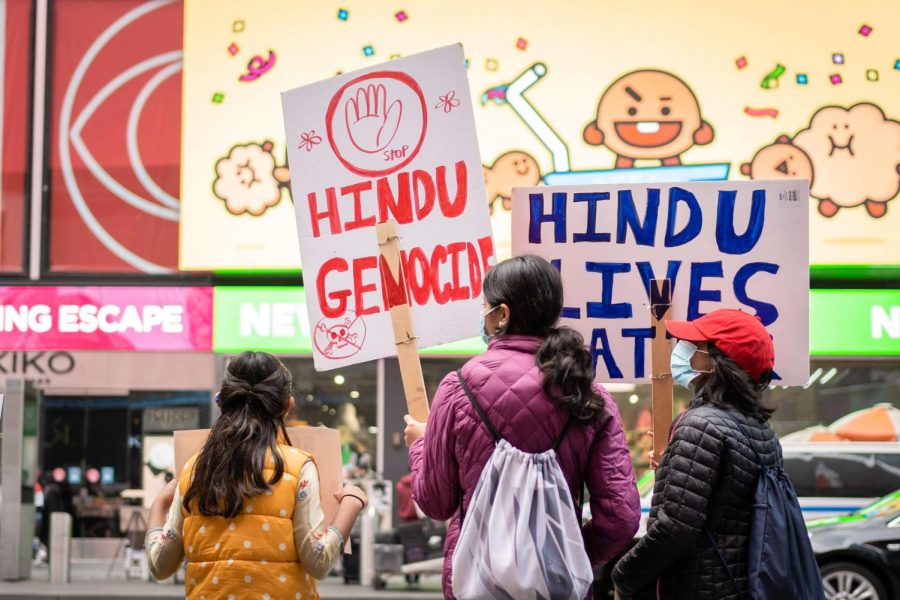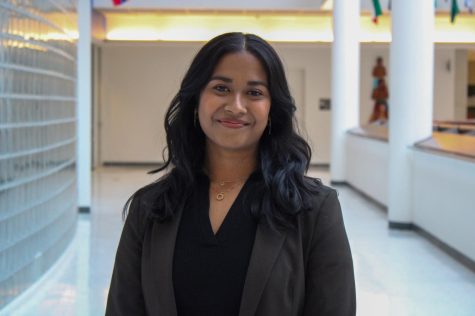The unspoken Hindu genocide in Bangladesh
October 28, 2021
Oct. 11 marked the beginning of Durga Puja, the religious holy week for Hindus this year. Devotees of the faith engage in a week-long celebration and prayer of Maa Durga, the God that defeated the devil. Idols of Durga typically pose her foot on top of the devil’s beheaded body to signify his vanquishment.
This time of year is always exciting for Hindus because they get to dress up in expensive sarees or kurtas and engage in week-long festivities at their local temples.
On Oct. 13, in the middle of this holy celebration, a Facebook post angered many in the Muslim majority of Bangladesh. The post featured a photo of a Durga idol with her foot posed on top of the Islamic holy book, the Qu’ran, instead of the devil’s body.
But the Facebook post is speculated to have been purposely created to provoke violence against Hindus. After further investigation, the Bangladesh police uncovered video footage revealing that a Muslim man, Iqbal Hossain, placed the Qur’an in the Hindu temple.
Authorities later uncovered that Hossain suffers from psychological issues that may have led him to do this. But that should not excuse him or the rest of the attackers.
Unfortunately, the post succeeded in inciting violence.
It worked so well that the violence has continued well past the end of the Durga celebrations, resulting in more than 100 injured, at least six dead and 80 Hindu temples attacked by mobs of up to 500 people. As of Oct. 19, 66 homes were vandalized and 22 were set on fire.
This is a sharp increase in violence from that which occurred during the 2020 celebration, where one person was killed, 27 injured and over 100 detained.
On top of this is the increase in rape of Hindu children and women in Bangladesh. In Haziganj of the Chandpur district, a 10-year-old girl, her aunt and her grandmother were gang-raped in this anti-Hindu wave. The girl died of blood loss. The aunt and grandmother were detained in police custody and refused to speak to any journalists, activists or relatives.
Bangladesh has not taken any productive action that would support the Hindu population or squash violence. Rather, Bangladesh has been implicitly supporting the violence for years.
This leaves most Hindus fearful of even bringing awareness to their persecution on social media.
On Oct. 18, Mia Seppo, the United Nations coordinator in Bangladesh, called for a stop to the religiously motivated violence against the minorities.
Bangladesh State Minister for Information, Murad Hassan, responded to the violence by asserting that the country will revert to their 1972 Constitution, which declared Bangladesh a secular country. This brings into question whether this will stop the communal attacks on Hindus.
Around 632 Hindus flee Bangladesh every day due to religious persecution and it’s estimated that there will be no more Bengali Hindus by 2050. The current Hindu population is about 9% but this number continues to decrease annually.
A secular nation is only secular in name if it doesn’t respect and protect its minorities.
The effects of this centuries-old feud will continue to reverberate throughout South Asia because the fact of the matter is that too many Hindu temples, homes and lives have been destroyed for decades to ever consider Bangladesh truly secular.
For anyone native to the South Asian countries, the Hindu-Muslim feud is not new.
Up until this point, India has refused to speak out against Bangladesh for its treatment of the Hindu minorities — this is no coincidence.
For India, news of Hindu persecution in Bangladesh will likely only strengthen their belief in a wholly theocratic, Hindu-led state. It will fuel anti-Muslim and pro-Hindu sentiments within the government and the treatment of the Muslim minority in India will only get worse.
Consequently, it is extremely pertinent that all Hindus and Muslims, whether they be Bangladeshi or Indian, condemn the recent violence in Bangladesh.
Despite the urgency of the matter, members of the Bangladeshi community are also slow to respond.
On Oct. 23 and 24, Bangladeshi Hindus took to the streets of Times Square, walking from the United Nations Headquarters, to protest and demand Bangladesh to act. The protests were led by the International Society for Krishna Consciousness. More than 100 such events led by ISCKON were held globally.
While the number of attendants at these protests is steadily increasing, the lack of awareness on social media and among the Bangladeshi community itself is disappointing.
Hindus are already the minority in a primarily Muslim country and yet hardly any Bangladeshi Hindus dare to speak out about the issue. Bangladeshi Hindus even label each other as too radicalized if they attend protests, raise awareness or demand justice to be brought to their people.
It is not radical to fear for one’s family’s life and demand a way to end that fear. This type of gaslighting within the Hindu community reflects a long line of internalized oppression.
It can be said that Hindus continue to be persecuted in Bangladesh due to clashing beliefs with the Muslim majority, but this is an oversimplification of the decades of hatred and anger that runs deep within these communities.
It is more likely that Hindu persecution and their internalized oppression are a result of Western imperialism.
Because Hinduism is so far removed from the majority of western, monotheistic religions, people will continue to marginalize and gaslight Hindus for their unconventional methods of worship.
But this should not be the case. No members of a religion should have to fear for their life, especially in the country they consider their home.
Imperialistic trauma continues to run deep within Hindu families that lack the resources to help their people. But their silence amid the chaos speaks volumes.
It is even louder when people have the resources and free will to help but choose not to. It is a free pass to allow the persecution to continue and remain in blissful ignorance as homes, lives and temples are destroyed.








